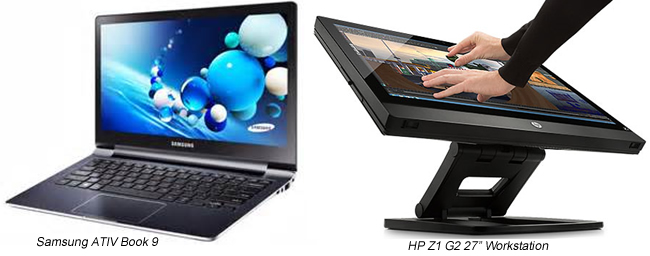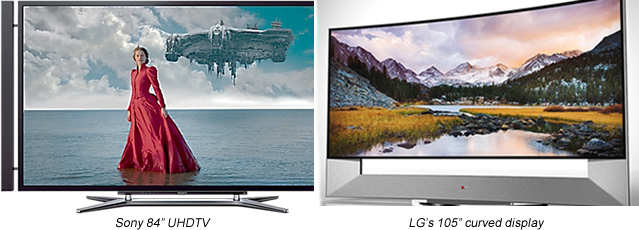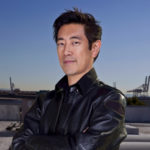Consumer Electronics in Transition at CES 2014
Once considered futuristic concepts, the consumer electronics in transition at CES 2014 will soon be ready for widespread adoption.
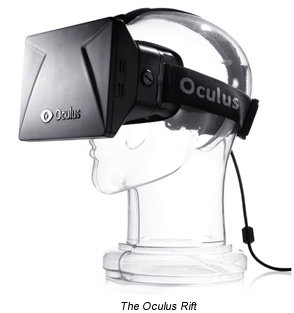 The past decade has been stellar for consumer electronics (CE). In many ways CE overshadowed business applications and became a key factor in driving unit volumes to new heights.
The past decade has been stellar for consumer electronics (CE). In many ways CE overshadowed business applications and became a key factor in driving unit volumes to new heights.
Key developments that drove this demand include:
- Worldwide consumer adoption of a wide array of new electronic products
- Apple’s emergence as a driving force in product innovation and consumer demand
- Explosive growth in multimedia, wireless technologies, applications, and electronic publications
- Blockbuster products like iPads, iPhones, and other smartphones; Android tablets; HDTV; and Ultrabooks
- Products and applications morphed across formerly disparate market segments – consumer, communications, computer, and automotive – causing both growth (ultramobile devices) and decline (traditional PCs).
The Consumer Electronics Show (CES) has taken on outsized importance and has become an important, expanding media event. This is the case despite Apple’s absence (the company holds its own event in San Francisco). In addition, to get attention, many of the products displayed at the show are only design concepts, and not yet available. Even so, their appearance at the show allows companies to gain market interest before investing in production.
In the past two years, some might say there has been a slowdown in blockbuster products, mainly because smartphones, tablets, and HD video products are now in product extension mode. But 2014 may have been a milestone of sorts, because the number and variety of new products and applications expanded significantly, including such markets as next-generation automotive, fitness products, and new technologies in mature markets, such as audio.
Let’s look at some of the best as rated by CNET and Techradar.
Virtual Reality Gaming
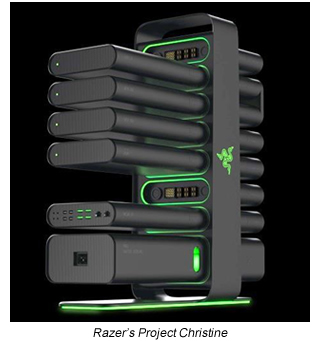 Gaming took center stage at CES 2014: Xbox 1, PlayStation 4, and Razer’s Project Christine, which is a gaming concept machine with plug-in modules that appear to include power blade and backplane connectors as I/O ports.
Gaming took center stage at CES 2014: Xbox 1, PlayStation 4, and Razer’s Project Christine, which is a gaming concept machine with plug-in modules that appear to include power blade and backplane connectors as I/O ports.
The Oculus Rift (above) is a gaming headset with 1080P resolution that produces breathtaking virtual reality gaming video combined with three-axis positioning and multiple IR sensors, and with what appears to be an HDMI (2.0?) connection.
Rift can be used with gaming PCs and could stream future virtual reality movies, be used as a training simulator, and more. Virtual reality is one of the next frontiers in personal computing. Video chip technology was pioneered by Kopin Corp. in 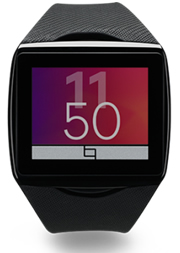 Westboro, Mass., and now, years later, a similar technology is being applied to wearable electronic products. It is amazing how long it takes for some technologies to reach important commercialization. One reason is simply that some developments are just ahead of their time: Hats off to the visionaries!
Westboro, Mass., and now, years later, a similar technology is being applied to wearable electronic products. It is amazing how long it takes for some technologies to reach important commercialization. One reason is simply that some developments are just ahead of their time: Hats off to the visionaries!
Smartwatches
Qualcomm has entered the fray with its Toq smartwatch technology. It uses Qualcomm’s Mirasol display technology, wireless charging, and a Bluetooth stereo ear bud. Mirasol uses ambient reflective display technology that is readable in broad daylight. The Toq can be purchased at Amazon.com for $349. Other smartwatch producers include Sony, Samsung, Pebble, ePrance, LG, and others. An offshoot of smartwatch technology is fitness watch bands that record calories burned and other aspects of fitness training.
Computers
Despite the serious downturn in conventional PC and laptop demand, there was no new breakthrough product at CES 2014. There were refinements, including 4K monitors, and Samsung introduced the powerful but ultrathin ATIV Book 9 with an Intel Core I7 CPU, 256GB of SS memory, HD audio, and a 3200×1800 pixel display. The ATIV Book 9 has two USB 3.0 ports, one RJ45, one microHDMI, and one SD card slot. It is so thin, I would love to see a teardown.
There were also a lot of new tablets and an increase in Google Chromebook offerings, but the PC market needs something dramatic to turn things around. Perhaps the best that can be said is that Windows tablets and convertibles are the new PCs and that total volume is still increasing. Microsoft is still perfecting their svelte Surface Pro offering, which has received positive reviews. We think the ATIV 9 is about as good as it gets in a mobile PC until some new PC technology appears.
There are many attractive convertible PCs and tablets. The HP Z1 G2 Workstation provides serious computing power in a modular, 27″ all-in-one desktop configuration. It sports several cooling fans, a Xeon processor, nVIDIA Tegra graphics processor, and three expansion slots (one mobile PCI Express, two mini PCIe/SATA).
4kx2k UHDTV
These were showcased by most of the major TV manufacturers, and several are already on the market, sans any meaningful 4k programming. Prices are coming down and the displays are stunning. This is a logical trend for TV technology but the bandwidth required to stream 8 million pixels is an issue. This is not stopping the TV industry, which sees this as an important part of the industry’s future.
Component video is still present, while most applications utilize HDMI and an optical audio port. Smart TVs are on the increase, but their user-friendliness has a way to go, particularly for web surfing.
Car Technology
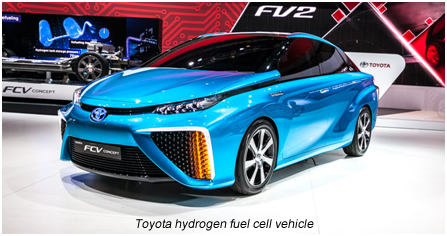 There was a lot of this at CES 2014. Among the developments was Toyota’s hydrogen fuel cell vehicle, essentially a hybrid Camry that will first be sold in California, where Toyota will initially install 40 fueling stations. The vehicle emits water vapor, but its indirect use of fossil fuel to produce hydrogen may detract from its green credentials. However, Toyota sounds bullish after also being first to market with hybrid technology. Toyota projects a ramp up in production by the end of 2015.
There was a lot of this at CES 2014. Among the developments was Toyota’s hydrogen fuel cell vehicle, essentially a hybrid Camry that will first be sold in California, where Toyota will initially install 40 fueling stations. The vehicle emits water vapor, but its indirect use of fossil fuel to produce hydrogen may detract from its green credentials. However, Toyota sounds bullish after also being first to market with hybrid technology. Toyota projects a ramp up in production by the end of 2015.
BMW demonstrated a 325i with driverless vehicle technology. The demo is sort of scary, but it does work. Several questions arise regarding government regulations and approvals, liability and insurance, cost-benefits, and the driving experience. This technology may be of more value as a driver-assist/safety application.
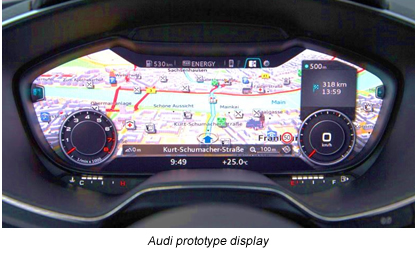 Dashboard display technology that emulates smartphone or tablet apps capability was also demonstrated. This would be an extension of existing GPS and entertainment technologies, also incorporating service reminders and monitoring performance. It will be a “go” so long as driver safety issues can be resolved.
Dashboard display technology that emulates smartphone or tablet apps capability was also demonstrated. This would be an extension of existing GPS and entertainment technologies, also incorporating service reminders and monitoring performance. It will be a “go” so long as driver safety issues can be resolved.
All in all, CES 2014 appears to have been a success, despite the tepid performance of world economies at the moment. As usual, it was a massive undertaking, but it looks like this year, many smaller companies and startups stole the show. The brightest spotlights were on UHDTV and wearable electronics, with automotive electronics demonstrating extraordinary applications on the rise, if the new economy supports it. And this year, no one technology dominated — there was much diversity.
The electronics industry deserves credit for continuing its long tradition of breakneck innovation, even in trying economic times.
John MacWilliams, Market Director, Bishop & Associates, Inc.
- Electric Vehicles Move into the Mainstream with New EV Battery Technologies - September 7, 2021
- The Dynamic Server Market Reflects Ongoing Innovation in Computing - June 1, 2021
- The Electronics Industry Starts to Ease Out of China - November 3, 2020
